Flower Growing Info
Annual Flowers
| Variety | Indoor Sowing Date | Days to Max Germination | Soil Temperature (℉) | Planting Depth | Weeks to Transplant |
| Ageratum | December-March | 7 | 75-78 | 1/8 inch | 8-10 |
| Alyssum | December-March | 8 | 78-82 | 1/6 inch | 10-12 |
| Amaranthus | December-March | 14 | 68-70 | 1/2 inch | 7-9 |
| Aster | January-April | 8 | 70-75 | 1/8 inch | 8 |
| Bachelor Button | February-March | 8 | 68-70 | 1/4 inch | 4-6 |
| Baby’s Breath | February-March | 8 | 68-72 | 1/4 inch | 6-8 |
| Celosia | January-April | 10 | 70-80 | 1/8 inch | 6 |
| Coleus | December-March | 10 | 70-75 | 1/4 inch | 6-9 |
| Cosmos | January-April | 5 | 68-72 | 1/4 inch | 6 |
| Daisies | February- March | 8 | 70-75 | 1/4 inch | 5-6 |
| Geraniums | November-February | 4-10 | 70-75 | 1/2 inch | 14-16 |
| Impatiens | December-March | 15 | 68-72 | 1/8 inch | 10-12 |
| Marigolds | January-April | 7 | 70-80 | 1/8 inch | 6-9 |
| Moon Flower | February-March | 8 | 70-75 | 1/4 inch | 6-8 |
| Morning Glory | February-March | 8 | 70-75 | 1/4 inch | 4-5 |
| Nasturtium | February-March | 8 | 70-74 | 1/2 inch | 6 |
| Pansy | November-February | 16 | 55-65 | 1/8 inch | 6-10 |
| Petunia | December-March | 10 | 70-80 | top | 10 |
| Salvia | December-March | 15 | 75-78 | 1/10 inch | 9 |
| Sunflower | February-March | 6 | 70-80 | 1 | N/A |
| Sweet Pea | February-March | 8 | 70-75 | 1 | 4-6 |
| Vinca | December-March | 15 | 70-80 | 1/4 inch | 12 |
| Zinnias | January-April | 7 | 68-72 | 1/8 inch | 5-8 |
Perennial Flowers
| Variety | Planting Depth | Indoor Sowing Date | Outdoor Sowing Date | Soil Temperature (℉) | Height (inches) | Spread (inches) | Soil | Light |
| Achillea | 1/8 inch | 6-8 | Early | 60 | 24-36 | 18 | Average, well-drained | Full |
| Black Eyed Susan | 1/4 inch | N/A | Anytime | 60 | 24-36 | 18 | Average | Full |
| Blanket Flower | 1/8 inch | 6 | 1-4 after | 70 | 24-40 | 14-16 | Loose | Full |
| Butterfly Flower | 1/8 inch | 6-8 | 1-4 after | 70 | 24-36 | 18-20 | Sandy, well-drained | Partial |
| Candytuft | 1/8 inch | 6-8 | Early | 65 | 1-15 | 8-10 | Well-drained | Partial |
| Coneflower | 1/4 inch | N/A | Early | 70 | 24-42 | 12-18 | Well-drained | Full |
| Coreopsis | 1/8 inch | N/A | 1-4 after | 70 | 18-48 | 6 | Moist | Full/Partial |
| Dahlia | 1/8 inch | 6-8 | Early | 65 | 12-36 | 16-24 | Rich, fertile | Full |
| Daisies | 1/8 inch | N/A | Early | 60 | 12-36 | 8-20 | Rich, well-drained | Full |
| Delphinium | 1/8 inch | 6 | 1-4 after | 60 | 12-48 | 18 | Average | Full/Partial |
| Dianthus | 1/8 inch | 6-8 | Early | 70 | 18-24 | 10-12 | Rich, well-drained | Full |
| Foxglove | 1/8 inch | N/A | Early | 65 | 24-60 | 24 | Average | Full/Partial |
| Geraniums | 1/8 inch | 6-10 | 1-4 after | 70 | 6-36 | 6-20 | Any soil | Full/Partial |
| Hosta | 1/2 inch | 6-10 | Early | 70 | 24-40 | 24-40 | Well-drained | Partial |
| Hollyhock | 1/8 inch | 6-8 | Early | 65 | 48-72 | 18-24 | Rich, well-drained | Full/Partial |
| Lupine | 1/8 inch | N/A | 2-4 after | 70 | 24-36 | 12-14 | Average | Full/Partial |
| Penstemon | Top | 6-8 | 2-6 | 70 | 12-36 | 18 | Loose | Full |
| Phlox | 1/8 inch | 6-8 | Early | 60 | 6-18 | 8-10 | Rich, loose | Full |
| Poppy | 3/8 inch | 6-8 | Anytime | 60 | 24-30 | 8-18 | Any soil | Full/Partial |
| Primrose | 1/8 inch | N/A | Early | 60 | 8-15 | 12-18 | Rich, moist | Full/Partial |
| Rudbeckia | 1/4 inch | N/A | Anytime | 60 | 24-36 | 12-24 | Average | Full |
| Tansy | 1/4 inch | N/A | Early | 65 | 36-48 | 6 | Average | Full/Partial |
| Viola | 1/8 inch | 6-8 | Early | 65 | 4-8 | 6 | Average | Partial |
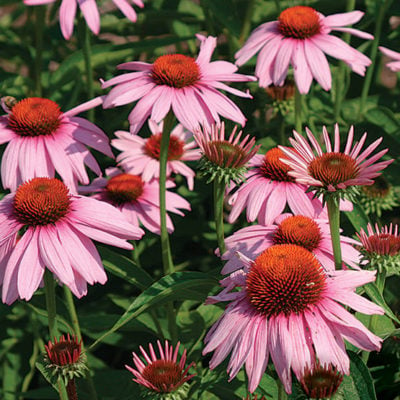
|
Coneflower (Echinacea) TipsLearning Download: How to Grow Echinacea Coneflowers are some of the easiest and most rewarding flowers you can grow. They attract birds and butterflies and can be cut and brought inside where they last a long time. Coneflowers should be directly sowed outside into your flower garden. Spread your seeds 12-18” apart to give adequate space to fully grow. Cover seeds with 1/4” of moist garden soil. Coneflowers do well in almost any soil and tolerate dry soil conditions very well. Be sure to water them during really dry periods to keep growing healthy. Coneflowers will do well when given a fertilizer once or twice a season. Coneflowers will grow to 24” to 42” tall and will form many branches. To encourage new blooms try cutting offall the dead blooms. Coneflowers are a very hardy flower and will survive the first light frost. Coneflowers reseed themselves and come back every year.
Suggest Varieties:
|
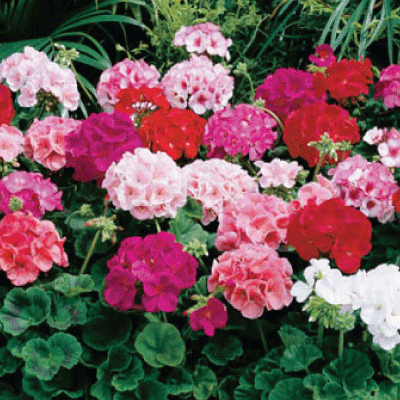
|
Geranium TipsLearning Download: How to Grow Geraniums Geraniums produce a nice bushy, upright habit with multiple, globe shaped flower heads. Geraniums are slow to germinate from seed, so be sure to start your seeds well ahead of your blooming expectations which could take 14-16 weeks from initial sowing. In order to increase germination rates, it helps to soak before sowing. A good method for geraniums is to dampen a few paper towels and fold over your geranium seeds. Place in a zip-lock bag and let sit for 24 hours. Plant a few seeds per pot in high quality soil at a depth of 1/2”. Geranium seeds do not need light to germinate and should have a constant soil temperature of 70-75 degrees. To ensure adequate moisture be sure to cover pots with plastic until you notice green sprouts. When they begin to sprout open plastic to vent and place in good sunlight. Once two true leaves appear (the first leaves are seed leaves), remove from plastic cover. Allow seedling to grow for a couple weeks and then transplant each seedling into its own pot. Keep soil moist and supply 12 hours of sunlight a day. Pinch off the top of plant once it’s growing strongly. This will promote branching and full growth.
Suggested Varieties:
|
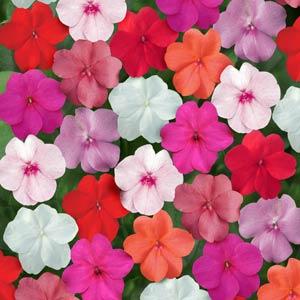
|
Impatien TipsLearning Download: How to Grow Impatiens Growing Impatiens yourself is a great money saver and fun experience. The annuals bloom bright, bold colors that adds a pop to any shady area in your garden. The ideal time to plant your Impatien seeds is 10-12 weeks before the last frost date of your location. Fill your pots with sterile seed starting mix and wet the soil. Place two seeds in each pot and cover with 1/8” of soil. Once the seeds have been planted it is important to cover the pots with plastic bags to keep the moisture in. Impatiens need grow lights or indirect light from a window. The soil temperature should be 70-75 degrees for maximum germination. Impatiens can sprout in as little as 7 days but can take as long as two weeks. If the temperatures are cooler it could even take longer. Be sure to remove plastic wrap as soon as the seedlings germinate. Impatiens are susceptible to fungal disease so be sure not to over water. When plants are adequate size they can be transplanted into your flower garden. Wait until all danger of the last frost has passed and be sure to harden the Impatien plants before transplanting.
Suggested Varieties:
|
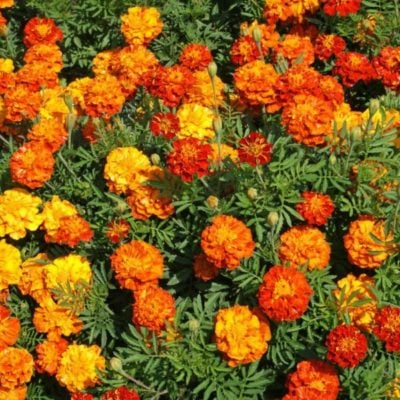
|
Marigold TipsLearning Download: How to Grow Marigolds Marigold plants are beautiful and easy to grow throughout the United States. They come in a multiple of colors, but orange hues are the most prevalent. Marigolds are easily grown from seeds in your flower garden. Marigolds can be grown inside 6-9 weeks before your last frost to get a jump start on the season. Starting indoors will ensure high germination and plant success. This also helps with proper spacing without the need to thin seedlings if directly sowed. After sowing seeds in soil cover lightly with 1/8” of moist soil. Be sure to water generously once after sowing. Seeds will germinate and grow quickly once sprouted. Give your Marigold plants at least 6” to “8 apart for dwarf varieties and a good 12” to 24” apart for Giant Marigolds. Marigolds love full sun and rich, well-drained soil. Add general purpose fertilizer once a month.
Suggested Varieties:
|
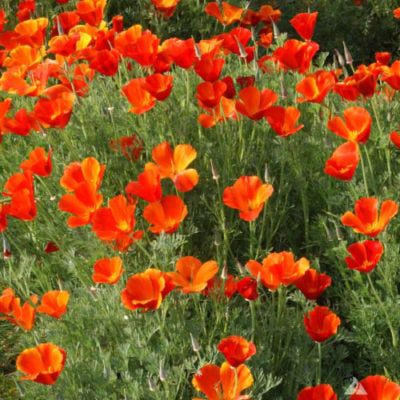
|
Poppy TipsLearning Download: How to Grow Poppies Poppy flowers are another flower garden favorite that grab attention and are fairly easy to propagate and care for. Poppies come in a variety of colors and sizes so find varieties that work best for your flower garden. Poppies can be started indoors or out. It depends when you want your flowers to bloom. Higher germination rates can be achieved with indoor sowing. Most poppy seeds should be sowed at 1/8” deep but some need light to germinate so be sure to read directions. Once sowed it is important to keep the soil moist but not soggy. It will take 10-15 days for your poppy seeds to germinate. Once they become seedlings begin to water every few days until transplant size. Space your poppy plants 6-8” apart for adequate spacing and growing room. When poppies die off you can de-head them and save the seeds for the next growing seasons. You can also let them fall when ready and you will have poppies early the next season! They will need to be thinned as natural sowing does not offer exact spacing.
Suggested Varieties:
|
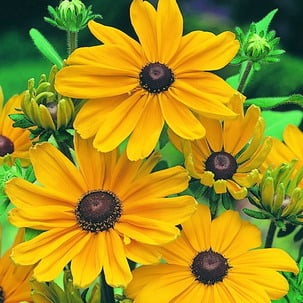
|
Rudbeckia (Black Eyed Susan) TipsLearning Download: How to Grow Rudbeckia The Rudbeckia flower can be grown in almost every state. These bright yellow, daisy-like flowers can grow 24”-36” high and are excellent to use for indoor flower arrangements. Theseflowers can be started indoors or out. Its best to start indoors 6-8 weeks before the last frost date of your location. Cover with 1/4” of moist soil and water occasionally. When starting or transplanting outside choose a location that receives full sun. Rudbeckias are very hardy and can survive in almost any soil conditions. If direct sowing into your flower garden sow 2 weeks before the last frost date. The best way to extend the flower blooms is to remove the dead flowers which will help direct more nutrient to healthy blooms. Most Rudbeckias are perennials that will come back every year. Be sure to plant where they have adequate room to grow for years.
Suggested Varieties:
|
